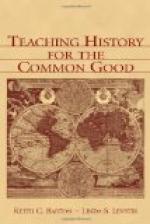As has already been intimated, history notes should not be kept in a book. The required notes should be kept on separate sheets of paper. The topics should be clearly indicated at the top of each sheet. The authorities used in arriving at the answer should always be given, with the volume, chapter, and page. The notes on related topics should be put into an envelope and properly labeled. After the recitation the student can make any necessary corrections in his notes without spoiling their appearance. He will simply substitute a new sheet for the old. If the teacher discovers in his periodic examination of the notes that some of the matter asked for has not been properly covered or that errors have not been corrected, the notes needing revision can be detained for use in a conference with the student, while the others are returned. If at any time after completing his high school work the student desires to use the data contained in his notes or to add to them matter which he may later read, they are in available form. For convenience and neatness, for present use, and future reference this device is far superior to the formal notebook. It has the further advantage of accustoming the student to the method of note-taking which will be required of those who go to college.
It would save much valuable time, at present frequently wasted in writing useless notes, if the teacher constantly squared his notebook requirements with questions such as these:—
1. Is the notebook
work as I am conducting it calculated to develop
the
habit of critical reading?
2. Does the time
spent in writing up notes justify itself by fixing
in
the child’s mind new and really relevant information
not
given
in the text?
3. Is it teaching
students to combine facts, opinions, and
statistics,
to form conclusions really their own?
4. Is the amount
of work required reasonable when it is remembered
that
the child has three other subjects to prepare, that
he is
from
thirteen to eighteen years of age, and more or less
unfamiliar
with a library?
5. Am I able carefully
and punctually to correct all the notes
required?
Whatever the method the teacher thinks best to be used should be explained early in the course and thereafter the student should be held scrupulously responsible for such requirements as are made.




